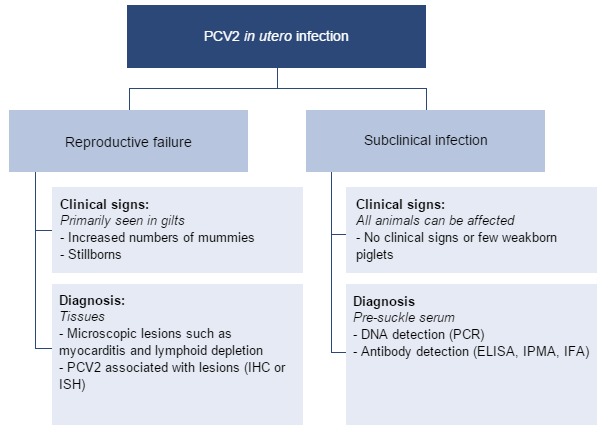Paper
Effect of porcine circovirus type 2 (PCV2) infection on reproduction: disease, vertical transmission, diagnostics and vaccination. DM Madson and T Opriessnig. Animal Health Research Reviews 12(1); 47–65. doi:10.1017/S1466252311000053

What are they studying?
The purpose of the paper is to provide an overview of the effects of PCV2 infections in sows, including vertical transmission, clinical signs, lesions, diagnosis and control by vaccination.
The authors summarise the current knowledge on PCV2 infections in sows and provide a classification system that differentiates between clinical reproductive failures associated to PCV2 and subclinical in utero infections of the foetuses.
What are the results?
The clinical presentation of PCV2-related reproductive failures is variable and depends on the timing of infection during gestation and the immune status of the sow. The most prominent clinical signs for PCV2 in utero infection are mummified and stillborn piglets. Abortions due to PCV2 are rare and most likely due to a systemic illness of the dam. Reproductive failures due to PCV2 are seen primarily in gilts, e.g. in newly established sow farms.

Subclinical infections are much more common and independent from the parity of the sow. In this case sows and piglets don’t show overt clinical signs, but the herd performance might be affected by a raise in return to oestrus, a reduced farrowing rate, an increase in weakborn piglets etc
What implications does this paper have?
PCV2 infections should be considered as a differential diagnosis for reproductive failures in sows and also in case of suboptimal reproductive herd performance. For the diagnosis of PCV2-associated reproductive failures the following criteria have to be fulfilled: clinical signs (mummified foetuses, stillborn or weakborn piglets etc.), microscopic lesion within foetal tissues (heart or lymphoid tissue), and PCV2 DNA has to be detected within foetal tissue. To increase the chance of detection of PCV2 in affected litters, 4 to 6 mummified, stillborn or weakborn pigs should be tested. Subclinical in utero infections can be identified by pre-suckle serum samples that are used for the detection of PCV2 DNA (PCR) or antibodies (ELISA, IFA).
Sow vaccination against PCV2 can increase the reproductive performance and reduce in utero infection of foetuses. To prevent intrauterine infections sow vaccination should be done pre-breeding or post farrowing.
|
When we think of reproductive problems we imagine serious problems of abortion or infertility. However, we rarely think that a slight increase in the number of mummified or stillborn piglets may be related to an infectious cause. In the case of PCV2 infections, we have known a long time that the virus can affect pregnant animals but, perhaps because the effects of the infection are inconspicuous or rare, vaccination of sows is not a common practice. It is true that more and more farms vaccinate replacement sows simply because the farmer does not want to run the risk of introducing negative sows —susceptible to infection during pregnancy— into the system. Since vaccination of piglets works so well, there is always the risk of generating batches of negative gilts. The immune status of farms is quite possibly different from the one they had before piglets mass vaccinations. We might even be surprised, especially where gilts are not vaccinated! All intrauterine infections that occur in advanced stages of pregnancy could affect the foetus myocardium, causing myocarditis. This is the case of intrauterine PPV, PRRS and PCV2 infections, as discussed in the article. Myocarditis, when mild, may not cause the immediate death of the animal, but it would be life-limiting when the animal's oxygen demands increased. In other words, those affected could die in phases of rapid growth (e.g., at the end of weaning or beginning of fattening.) In recent years, we have seen how a small percentage of holdings, even though they are vaccinating piglets, still show clinical signs suggestive of PCV2 infection, and in some cases myocarditis lesions have been observed in the heart of some of the affected animals. Could they be due to an intrauterine infection? Could vaccination of sows limit the occurrence of some of these cases? |







